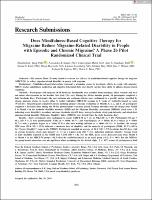Please use this identifier to cite or link to this item:
https://hdl.handle.net/20.500.12202/10100| Title: | Does mindfulness-based cognitive therapy for migraine reduce migraine-related disability in people with episodic and chronic migraine? A phase 2b pilot randomized clinical trial. |
| Authors: | Seng, Elizabeth K. Singer, Alexandra B. Metts, Christopher Grinberg, Amy S. Patel, Zarine S. Marzouk, Maya Rosenberg, Lauren Day, Melissa Minen, Mia T. Lipton, Richard B. Buse, Dawn C. 0000-0002-8938-4949 |
| Keywords: | Mindfulness Cognitive Therapy Migraine -- Therapy Disability Management Randomized Controlled Trials Treatment Outcomes Referral and Consultation Migraine -- Diagnosis Treatment Duration Disability Evaluation Severity of Disability Pain Measurement |
| Issue Date: | Oct-2019 |
| Publisher: | Wiley-Blackwell |
| Citation: | Seng, E. K., Singer, A. B., Metts, C., Grinberg, A. S., Patel, Z. S., Marzouk, M., Rosenberg, L., Day, M., Minen, M. T., Lipton, R. B., & Buse, D. C. (2019). Does mindfulness-based cognitive therapy for migraine reduce migraine-related disability in people with episodic and chronic migraine? A phase 2b pilot randomized clinical trial. Headache, 59(9), 1448-1467. |
| Series/Report no.: | Headache: The Journal of Head & Face Pain;59(9) |
| Abstract: | •Objective: The current Phase 2b study aimed to evaluate the efficacy of mindfulness‐based cognitive therapy for migraine (MBCT‐M) to reduce migraine‐related disability in people with migraine. •Background: Mindfulness‐based interventions represent a promising avenue to investigate effects in people with migraine. MBCT teaches mindfulness meditation and cognitive‐behavioral skills and directly applies these skills to address disease‐related cognitions. •Methods: Participants with migraine (6‐30 headache days/month) were recruited from neurology office referrals and local and online advertisements in the broader New York City area. During the 30‐day baseline period, all participants completed a daily headache diary. Participants who met inclusion and exclusion criteria were randomized in a parallel design, stratified by chronic migraine status, to receive either 8 weekly individual MBCT‐M sessions or 8 weeks of waitlist/treatment as usual (WL/TAU). All participants completed surveys including primary outcome evaluations at Months 0, 1, 2, and 4. All participants completed a headache diary during the 30‐day posttreatment evaluation period. Primary outcomes were the change from Month 0 to Month 4 in the headache disability inventory (HDI) and the Migraine Disability Assessment (MIDAS) (total score ≥ 21 indicating severe disability); secondary outcomes (headache days/30 days, average headache attack pain intensity, and attack‐level migraine‐related disability [Migraine Disability Index (MIDI)]) were derived from the daily headache diary. •Results: Sixty participants were randomized to receive MBCT‐M (n = 31) or WL/TAU (n = 29). Participants (M age = 40.1, SD = 11.7) were predominantly White (n = 49/60; 81.7%) and Non‐Hispanic (N = 50/60; 83.3%) women (n = 55/60; 91.7%) with a graduate degree (n = 35/60; 55.0%) who were working full‐time (n = 38/60; 63.3%). At baseline, the average HDI score (51.4, SD = 19.0) indicated a moderate level of disability and the majority of participants (50/60, 83.3%) fell in the "Severe Disability" range in the MIDAS. Participants recorded an average of 16.0 (SD = 5.9) headache days/30 days, with an average headache attack pain intensity of 1.7 on a 4‐point scale (SD = 0.3), indicating moderate intensity. Average levels of daily disability reported on the MIDI were 3.1/10 (SD = 1.8). For the HDI, mean scores decreased more from Month 0 to Month 4 in the MBCT‐M group (−14.3) than the waitlist/treatment as an usual group (−0.2; P < .001). For the MIDAS, the group*month interaction was not significant when accounting for the divided alpha, P = .027; across all participants in both groups, the estimated proportion of participants falling in the "Severe Disability" category fell significantly from 88.3% at Month 0 to 66.7% at Month 4, P < .001. For diary‐reported headache days/30 days an average headache attack pain intensity, neither the group*month interaction (Ps = .773 and.888, respectively) nor the time effect (Ps = .059 and.428, respectively) was significant. Mean MIDI scores decreased in the MBCT‐M group (−0.6/10), whereas they increased in the waitlist/treatment as an usual group (+0.3/10), P = .007. Conclusions: MBCT‐M demonstrated efficacy to reduce headache‐related disability and attack‐level migraine‐related disability. MBCT‐M is a promising emerging treatment for addressing migraine‐related disability. |
| Description: | Scholarly article / Open access |
| URI: | https://hdl.handle.net/20.500.12202/10100 |
| ISSN: | 0017-8748 |
| Appears in Collections: | Ferkauf Graduate School of Psychology: Faculty Publications |
Files in This Item:
| File | Description | Size | Format | |
|---|---|---|---|---|
| Seng - Headache - 2019 -OADoes Mindfulness‐Based Cognitive.pdf | 969.64 kB | Adobe PDF |  View/Open |
This item is licensed under a Creative Commons License

